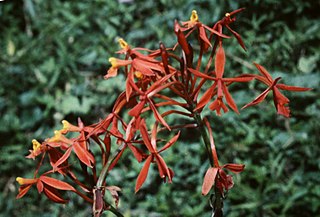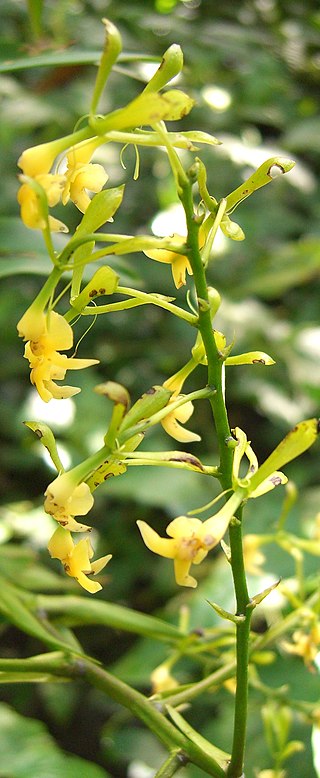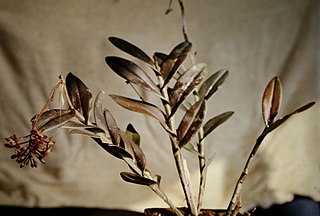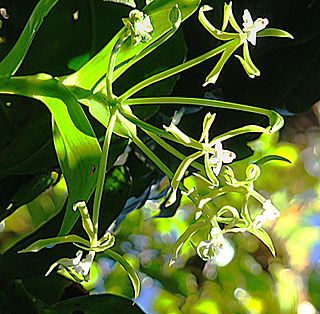
Epidendrum armeniacum is an epiphytic species of reed-stemmed Epidendrum orchid that grows wild in Bolivia, Brazil, Ecuador, and Peru, at altitudes of 1–2 km.

Epidendrum blepharistes is a species of orchid in the genus Epidendrum native to Bolivia, Colombia, Costa Rica, Ecuador, Peru, and Venezuela.

Epidendrum compressum is a species of flowering plant in the family Orchidaceae . It is from wet montane forests of Trinidad, Venezuela, Colombia, Ecuador, Peru and Bolivia.

Epidendrum friderici-guilielmi is a species of orchid in the genus Epidendrum which grows naturally at altitudes of 1.7—3.0 km. in Peru and Bolivia.

Epidendrum macrocarpum, widely known as Epidendrum schomburgkii, is a species of orchid in the genus Epidendrum, and the largest-flowering crucifix orchid species. Reichenbach thought that E. fulgens and E. schomburgkii var. confluens were both synonyms for this species.

Epidendrum microphyllum is a species of tropical orchid in the genus Epidendrum with non-resupinate flowers.

Epidendrum paniculatum is a species of orchid in the genus Epidendrum.

Epidendrum orchidiflorum is a species of orchid of the genus Epidendrum.
Epidendrum brevivenium is a species of Epidendrum Orchid native to Peru and the provinces of Pichincha, Napo, and Tungurahua in Ecuador at altitudes of 2.8 to 3.4 km.

Integra is a subsection of the section Schistochila of the subgenus Amphiglotium (Lindl.) of the genus Epidendrum of the Orchidaceae. Like the other subsections of Schistochila, Integra plants are sympodial orchids with no tendency to produce pseudobulbs. They bear a terminal inflorescence with a peduncle covered for most of its length with close, thin, imbricate sheaths, and terminating in a raceme. This subsection differs from the other two in that the margins of the trilobate lip are not lacerate, fringed, or denticulate. In 1861, Reichenbach listed fifteen separate species in this subsection. Some of these names are now recognized as synonyms
Epidendrum hemiscleria is a sympodial epiphytic orchid native to the tropical cloud forest of Ecuador and Peru, at altitudes near 3.3 km.
Epidendrum sect. Holochila Rchb.f. 1861 is a section of subgenus Epidendrum subg. Amphiglottium of the Orchidaceae. It differs from section E. sect. Polycladia by bearing inflorescences that are racemes, not panicles. It differs from section E. sect. Schistochila by having a lip with no lobes. Like the other sections of E. subg. Amphiglottium, plants of E. sect. Holochila exhibit slender stems covered with close imbricating sheaths which do not swell to form pseudobulbs, and terminal inflorescences covered at the base with close imbricating sheaths but without spathes.
Epidendrum smaragdinum is an epiphytic sympodial orchid native to the Neotropics. It has been found at 0.5 km above sea level in Napo, Ecuador It is also known from Brazil, French Guiana, Guyana, Peru, Suriname, and Venezuela.
Epidendrum ramosum, the mountain star orchid, is a neotropical species of reed-stemmed Epidendrum orchid which grows both epiphytically and terrestrially at altitudes near 1 km.
Epidendrum spruceanum is an epiphytic reed-stemmed Epidendrum orchid native to the Tropical rainforest of Peru, Bolivia, and Brazil.

Epidendrum lacustre is a sympodial orchid which is known to grow both epiphytically and lithophytically in the cloud forests and rainforests of Colombia, Costa Rica, Ecuador, Nicaragua, Peru and Venezuela at altitudes ranging from 1.2—2.5 km. The type of this species was found growing "on half-submerged rotten trees" in a Venezuelan marsh at an altitude of 2.4 km.
Epidendrum cochlidium is a neotropical orchid which can grow both terrestrially and epiphytically in Peru and Venezuela at altitudes ranging from 1.2 km to 2.9 km.

Epidendrum coriifolium is a sympodial orchid which grows both terrestrially and epiphytically at altitudes of 1.4—1.7 km in dense forests in Brazil, Ecuador, Mexico, Central America, and Venezuela.
Epidendrum cylindraceum is a reed-stemmed Epidendrum of the Orchidaceae, native to Colombia, Ecuador, and Peru, where it has been reported at an altitude of 3.2 km.

Epidendrum cylindrostachys is an epiphytic orchid native to the mountainous rainforest of Colombia and Peru, at altitudes near 2.5 km. According to the World Checklist, this binomial has no synonyms or homonyms.












